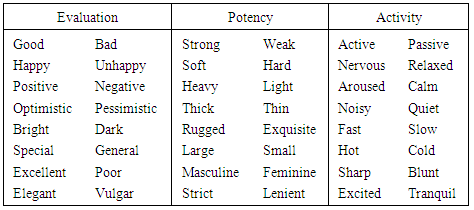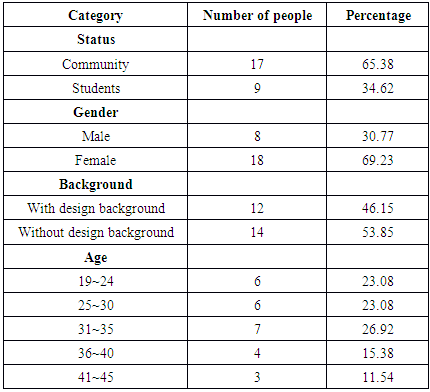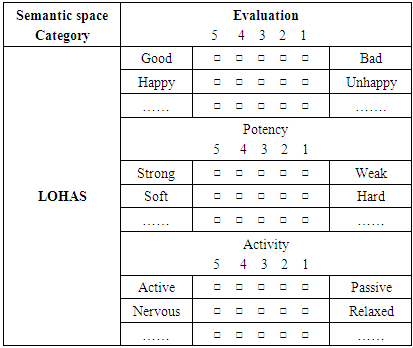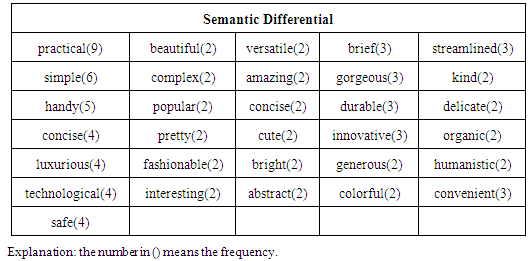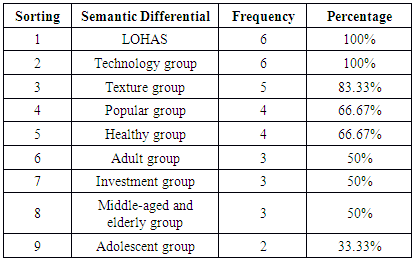-
Paper Information
- Paper Submission
-
Journal Information
- About This Journal
- Editorial Board
- Current Issue
- Archive
- Author Guidelines
- Contact Us
American Journal of Sociological Research
p-ISSN: 2166-5443 e-ISSN: 2166-5451
2016; 6(5): 117-125
doi:10.5923/j.sociology.20160605.01

Using Semantic Differential to Study Expected Images Expect Vocabulary on Design and Lifestyle Ethnic Groups
Peng-Jyun Liu1, 2, Ming-Chuen Chuang1
1Institute of Applied Arts, National Chiao Tung University, Taiwan, ROC
2Department of Creative Product Design, Asia University, Taiwan, ROC
Correspondence to: Peng-Jyun Liu, Institute of Applied Arts, National Chiao Tung University, Taiwan, ROC.
| Email: |  |
Copyright © 2016 Scientific & Academic Publishing. All Rights Reserved.
This work is licensed under the Creative Commons Attribution International License (CC BY).
http://creativecommons.org/licenses/by/4.0/

The appeal of consumers choosing their products has changed from being functionally practical to sensational, and sensation has already become the main motivation for consumers to choose their products. Also, lifestyle ethnic groups are the most favorable analyzed subjects of marketing currently, so making good use of ethnic lifestyle group analysis to penetrate the consumer market in Taiwan will be helpful for operators of different industries to realize the characteristics of potential consumers. In the future, all kinds of lifestyle ethnic groups will be targeted to conduct deeper observation, investigation, and research of specific themed products or services. This research will hold 2 expert group seminars respectively though literature review, expert group seminars, and Method of Semantic Differential, and 131 total questionnaires will be distributed in two batches to implement a three-phase experimental survey and conduct research on three lifestyle ethnic groups and their corresponding Semantic Differential. The research results obtained the 31 most commonly used Semantic Differentials on design, and the 3 most often encountered lifestyle ethnic groups on design, which are LOHAS, the technology group, and texture group. Meanwhile, the respective image expect vocabulary of the three lifestyle ethnic groups will also be obtained, for example, the images expect vocabulary of LOHAS is practical, simple, and organic. The images expect vocabulary of the technology group is versatile, streamlined, innovative, and technological. The images expect vocabulary of the texture group is fashionable, popular, luxurious, and abstract. Through the results of the research, we can also obtain that (1) different lifestyle ethnic groups actually have different corresponding Semantic Differentials, and (2) not all of the commonly used Semantic Differentials on design are suitable for different lifestyle ethnic consumption groups, so the extraction of Semantic Differentials should actually be put in more detailed divisions. Moreover, (3) the Semantic Differentials decided by different designers on different lifestyle ethnic groups might lead to the distortion of the extraction of designing elements because the deciding process is too rough. Also, (4) the research of the relevance among different lifestyle ethnic groups, Semantic Differentials, and images can be conducted subsequently, and the e-platform of an image billboard can be constructed to be a tool able to support and operate during design.
Keywords: Lifestyle ethnic groups, Image expect vocabulary, Semantic Differential
Cite this paper: Peng-Jyun Liu, Ming-Chuen Chuang, Using Semantic Differential to Study Expected Images Expect Vocabulary on Design and Lifestyle Ethnic Groups, American Journal of Sociological Research, Vol. 6 No. 5, 2016, pp. 117-125. doi: 10.5923/j.sociology.20160605.01.
Article Outline
1. Introduction
- In recent years, the appeal of consumers choosing their products has changed from being functionally practical to sensational, and sensation has already become the main motivation for consumers to choose their products. One of the targets for product design is to arouse the motivation of consumers to purchase products, so the sensational appeal of products becomes a very important core in the design. In order to reach the goal, designers often introduce many different methods in the process of design to stimulate the design thinking, and the implementation of an image billboard is one of the most common methods. A visualized image billboard is more direct and more imaginative, which can trigger ideas quickly, boost the efficiency of the communication between designers and clients, and condense and integrate the consensus of the designing team. During the product design, the implementation of an image billboard not only can inspire more innovation during development but also be a reference for planning the diversification of products and development of separate products.Lifestyle ethnic groups are currently the most common consumer behavior analysis in marketing. For example, Eastern Online Co. Ltd. and the NCCU MBA program combine to create E-ICP Eastern Integrated Consumer Profiles (2016) to provide the data for consumer market analysis every year through large household surveys of Taiwanese consumer subject lifestyle research. The results of this lifestyle research can depict the characteristics of high potential consumers more precisely and analyze which group the customers that the operators want to contact belong to. Therefore, making good use of ethnic lifestyle group analysis to penetrate the consumer market in Taiwan will be helpful for operators of different industries to realize the characteristics of potential consumers. In the future, all kinds of lifestyle ethnic groups will be targeted to conduct deeper observation, investigation, and research on specific themed products or services.The Semantic Differential that operates an image billboard has much research conducting extraction of Semantic Differentials based on the characteristics of products, which less matches and pairs with lifestyle ethnic groups having the current characteristics of consumers. The intention of the research preliminarily explores Semantic Differentials and lifestyle ethnic groups, matches them through expert seminars and uses them as the basis of the database for Semantic Differentials and lifestyle ethnic groups, and they can also be the reference for designers or the industry to develop or orient products in the future. Moreover, they can also be used as tools during the operation of design courses academically.The project takes the lifestyle billboard with larger dimensions, proposed by the research results of Baxter, as the main research subject to construct the relevant Semantic Differential database of lifestyle consuming ethnic groups respectively and solve the problem that collecting Semantic Differentials is decided subjectively by designers and cannot be combined with the current lifestyles of consumer groups. The research is based on a survey of the Semantic Differentials commonly used by designers and supplemented by the Semantic Differentials corresponding to the characteristics of lifestyle ethnic groups. The obtained results can improve the expectations of lifestyle ethnic groups and the appropriateness of the Semantic Differential expression, so the results of this research are suitable for cooperative design or participatory design and are able to solve the problems of image cognition difference of different participants. The targets reached in this research are as follows:1. Find out the lifestyle ethnic groups commonly used for product design2. Obtain the images commonly used in all kinds of product design3. Obtain the images corresponding to different lifestyle ethnic groups.The process of designing or orienting the development of products always requires a larger amount of time to collect relevant information and it is possible that the expected ideal of design cannot be reached. By the construction of a database for image billboards, providing the appropriate Semantic Differential, ethnic lifestyle group, and other relevant information enables designers to obtain the most proper design image decision and to help designers to get the best design referring factors.In light of there currently being powerful search engines on the internet, searching for the relevant information is done by using keyword searches to promptly obtain and decide the precise Semantic Differential as the basis of keyword searches. Meanwhile, it can also be combined with lifestyle ethnic groups and be seen as the preliminary research exploration of designing innovative tools. The construction of the database corresponding to lifestyle ethnic groups and Semantic Differentials in this research is done by taking lifestyle ethnic groups as the entry point and taking human living patterns to conduct the data collection of Semantic Differentials, which is an innovative method to construct a database and an innovative highlight on the foresight of the designing and exploring phase.
2. Literature Review
- The generation of images can be divided into two methods. One of them is obtained directly from their own culture, including life experience, social customs and regulations, life background, and so on. The other one is cognition that conveys images to the brain through indirect stimulation, such as the imagination after reading an article, the thoughts after appreciating an art work, and so on. Therefore, we can say that images are objectively the processed image formed in the thinking space after the cognitive subject contacts the objective things and transmits the image data according to the source of feelings. Furthermore, the overall structure of the physical memory trace left in the brain can be divided into the internal and external parts, and the internal part is meaning and the external part is symbol (Wikipedia, 2014), while most scholars from different fields think that image consists of cognitive and affective (Dobni & Zinkhan, 1990), including cognitive image and affective image. Cognitive image is the personal attitude and perception, and affective image is the personal recognition of image properties and characteristics (Martine, 2007). The Japanese kansei engineering expert, Mitsuo Nagamichi (1995), also proposed that images are abstract and non-concrete and the association of images is related to the life experiences and cultural background of consumers. In other words, images are closely related to personal lifestyles.The product itself includes “meaning” and “symbol.” To the design activity, meaning is the implementation of the design concepts from the designers and the conveyance of designing messages, while to consumers, it is the meaning that consumers feel about the sign. In particular, it is also the product language. Symbol is the concrete presentation of the product style (Ping-Chieh Chang, 2005). The conveyance of image is to send messages to consumers through products, so the same message will generate different images to different consumers because consumers have different life background, experiences, education levels, knowledge, and so on. The cognition of images is a kind of mental activity, and the identifying process of the product image is guided mainly in two ways (Ping-Chieh Chang, 2005), which is the overall image identification of people to the products and the overall image obtained from the analysis of the product characteristics. Wei-Yu Chen (2000) proposed the communication and conveyance pattern between designers and users (figure 1) and thought that products are the carrier to convey the image of designers and the important symbol and instruction of feeling is the consuming message and communication.
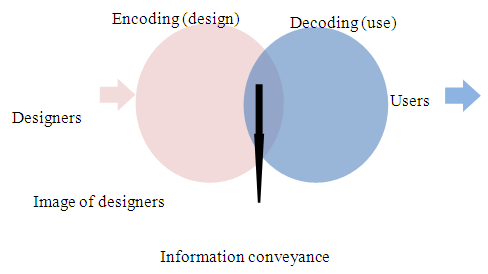 | Figure 1. The communication and conveyance pattern between designers and users (Wei-Yu Chen, 2000) |
|
3. Methods
- In order to efficiently and definitely explore the themed lifestyle of this research and construct a Semantic Differential database, this research refers to the related information through literature review, such as the research and survey methods to use, the sample types to use, the methods to handle stimulation, the experiment process and steps, and others in related research. We plan a three-phase survey and research process by this and explore them by the order of 1. The commonly used Semantic Differential, 2. The commonly used Semantic Differential in lifestyle ethnic groups for all kinds of products, and 3. The Semantic Differential corresponding to different lifestyle ethnic groups. The following will explain the research methods and purposes of every phase.
3.1. The Survey of Commonly Used Semantic Differentials in Design
- The research target in the first phase is mainly to survey the commonly used Semantic Differentials in design through collecting the commonly used Semantic Differentials in lifestyle ethnic groups and those in the design of all kinds of products. The adopted research methods are mainly literature review and questionnaire surveys. First, collect a great amount of Semantic Differentials related to design from literature, data, newspapers, magazines, and others, and adopt the commonly used Semantic Differential on product design proposed by Tai-Sheng Huang (2007) as the basis according to the commonly used design semantic by designers from literature review.Moreover, considering that Semantic Differentials will change slightly as time goes by, we designed another open-ended questionnaire and invited the subjects with and without a design background to fill in the questionnaire online in order to collect Semantic Differentials in design extensively. The subjects in this phase were chosen by random sampling to fill in the questionnaire online. The tool is an open-ended questionnaire designed by the research team, and the basic information of the 26 subjects is shown as table 2. Collecting and organizing the final results of both, we obtained the most commonly used Semantic Differentials.
|
3.2. The Survey of Commonly Used Semantic Differentials in All Kinds of Products for Lifestyle Ethnic Groups
- The target of the second phase is to collect the commonly used lifestyle ethnic groups in all kinds of products and the images expect vocabulary of the groups. The research methods adopted are literature survey and expert group seminars. According to the results of the literature survey, the basic information of the ethnic lifestyle group adopts E-ICPs (Eastern Integrated Consumer Profiles), which are the result of cooperation between Eastern Online Co. Ltd. and the NCCU MBA program. Emphasizing the survey of consumer information's lack of objectivity and comprehensiveness in the domestic marketing environment, E-ICP belongs to long-term research and has conducted the survey of consumer lifestyle and consumption behaviors in Taiwan every year since 1988 and it can definitely be tested by its validity, which has now become the database of the research of consumer lifestyles covering the most area in Taiwan. The survey is an integrated survey taking 2000 consumers as the center, and the survey aspects cover population statistics, lifestyles, daily leisure, media contact, and real product purchases. The survey results of the research that objectively collects the complete aspects of the consumer lifestyle in 2015 divided lifestyle ethnic groups into seven major categories, and the nine lifestyle ethnic groups are shown as figure 2.
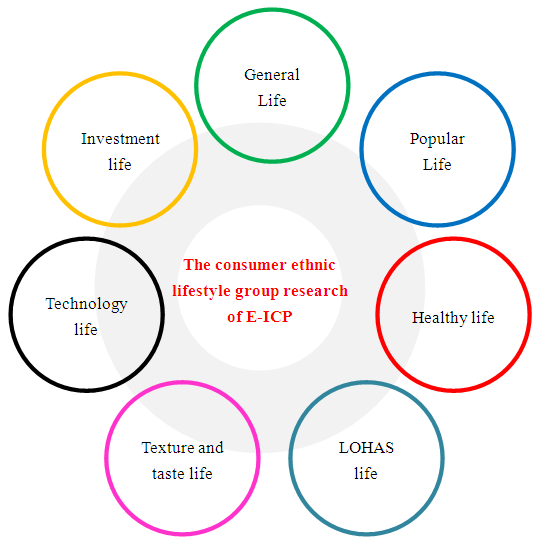 | Figure 2. E-ICP research result of consumer ethnic lifestyle group (Eastern Online Co. Ltd., 2015) |
|
|
3.3. The Survey of Images Expect Vocabulary Corresponding to Lifestyle Ethnic Groups
- The research target of the third phase is to find the Semantic Differentials corresponding to an ethnic lifestyle group, and the adopted method is a questionnaire survey. The design of the questionnaire uses the three dimensions of semantic space proposed by Osgood as the rating scale and adopts the Likert Scale (shown as table 5). The questionnaire survey adopts random convenience sampling and conducts surveys through online and paper questionnaires, and 35 subjects are expected to be invited for each lifestyle to fill in the questionnaire, so there are 105 total subjects participating in the experimental survey. At the end, the survey results will find out the images expect vocabulary corresponding to lifestyle ethnic groups through profile matching.
|
4. Research Results
- Based on the experimental survey of three phases, the research survey results are described as follows.
4.1. The Commonly Used Semantic Differentials in Design
- Through the results of literature review and an open-ended questionnaire survey, the overall number of collected Semantic Differentials was 160, and there were 101 total words after we integrated the same words. Next, through the statistic of frequency, we adopted the words whose frequency was 2 or above to be the commonly used Semantic Differential in design. Among them, “practical” has the most frequency with 9, “simple” has the frequency of 6, ”handy” has the frequency of 5, ”concise", “luxurious”, “technological”, and “safe” have the frequency of 4, and ”brief”, “gorgeous”, “durable”, “innovative”, “convenient”, “streamlined”, and others have the frequency of 3, and all of the above are shown as table 6. After we collected and organized, there were 31 total commonly used Semantic Differentials in design.
|
4.2. The Commonly Used Semantic Differentials in Lifestyle Ethnic Groups for All Kinds of Products
- According to the consumer ethnic lifestyle group research of E-ICP, there are 7 total categories of lifestyle ethnic groups and the E-ICP database is used to provide the characteristics of lifestyle ethnic groups respectively for 6 experts as the reference. The first step of the experimental survey is to ask experts and scholars to choose the commonly used lifestyle ethnic groups in design, and calculate the chosen lifestyle ethnic groups and sort them. The top 3 groups in the sorting are the ethnic lifestyle group subjects in this research, which are LOHAS, the technology group, and texture group. The survey results are shown in table 7.
|
|
4.3. The Images Expect Vocabulary Corresponds to Lifestyle Ethnic Groups
- According to the questionnaire survey of different lifestyle and Semantic Differentials, we first add up the score of the semantic space of every lifestyle, and get the questionnaire survey results of the subjects of the three kinds of semantic space. Next, we get the average score and standard deviation of every semantic image scale, and we can draw up a profile figure based on the average score. From the figure, we can know that the expected images expect vocabulary closest to the lifestyles of LOHAS is practical, simple, and organic (as figure 3).
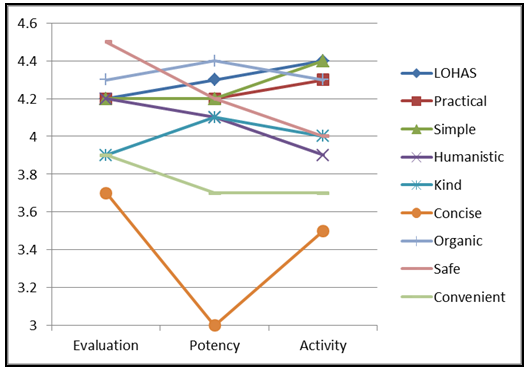 | Figure 3. The profile figure of expected images expect vocabulary for LOHAS |
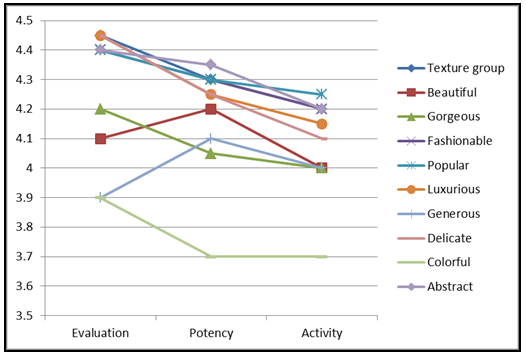 | Figure 4. The profile figure of expected images expect vocabulary for the technology lifestyle ethnic groups |
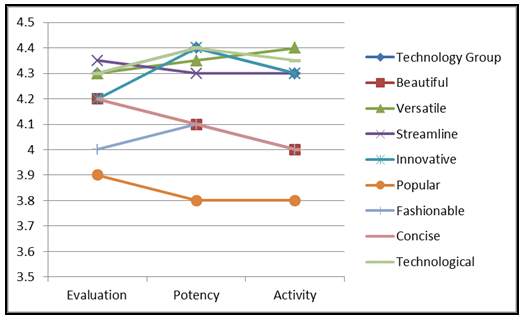 | Figure 5. The profile figure of the images expect vocabulary for the texture ethnic lifestyle group |
5. Conclusions
- Through the experimental survey results for three phases, we can obtain the following definite conclusion for the extraction of the Semantic Differentials for the three different lifestyle ethnic groups (LOHAS, technology group, and texture group).1. Different lifestyle ethnic groups actually have different corresponding Semantic Differentials.2. Not all of the commonly used Semantic Differentials on design are suitable for different ethnic lifestyle consumption groups, so the extraction of Semantic Differentials should actually be put into more detailed divisions.3. The Semantic Differentials decided by different designers on different lifestyle ethnic groups might lead to the distortion of the extraction of designing elements because the deciding process is too rough.4. The cognition of the subjects to the images of lifestyle ethnic groups can be expressed by a three-dimensional space composed of three factors, which are evaluation, potency, and activity. The highest score in the evaluation factor of LOHAS is “safe”, while the highest score in the evaluation factor of the technology group is “streamlined”, and the highest score in the evaluation factor of texture group is “delicate” and “luxurious.” The highest score in the potency factor of LOHAS is “organic”, while the highest score in the potency factor of the technology group is “technological” and “innovative”, and the highest score in the potency factor of the texture group is “abstract.” The highest score in the activity factor of LOHAS is “simple”, while the highest score in the activity factor of the technology group is ”versatile”, and the highest score in the activity factor of the texture group is “popular.”From the research above, we definitely found out the expected images expect vocabulary for the three lifestyle ethnic groups, and we have the following suggestions on improving the conducted extraction of Semantic Differentials, which takes lifestyle ethnic groups as the main perspective.1. So far, the phase of design exploration and product development has largely adopted lifestyle ethnic groups as the referring basis of research, development, and orientation of the products on the market, so we suggest that any design or marketing planning related to Semantic Differentials should further conduct the preparatory research of images expect vocabulary for lifestyle ethnic groups in order to make sure the products are close to the demands of consumers.2. The results of the preliminary stage of this research might be used to conduct the extraction of an images expect vocabulary for other lifestyle ethnic groups and enhance the effects and accuracy of Semantic Differentials one by one. 3. The research of the relevance among different lifestyle ethnic groups, Semantic Differentials, and images can be conducted subsequently, and the e-platform can be constructed to be a tool able to operate an image billboard during design.
ACKNOWLEDGEMENTS
- We are grateful to the Ministry of Science and Technology, R.O.C for providing funding for the study of the program and for all the people involved in the project.
 Abstract
Abstract Reference
Reference Full-Text PDF
Full-Text PDF Full-text HTML
Full-text HTML